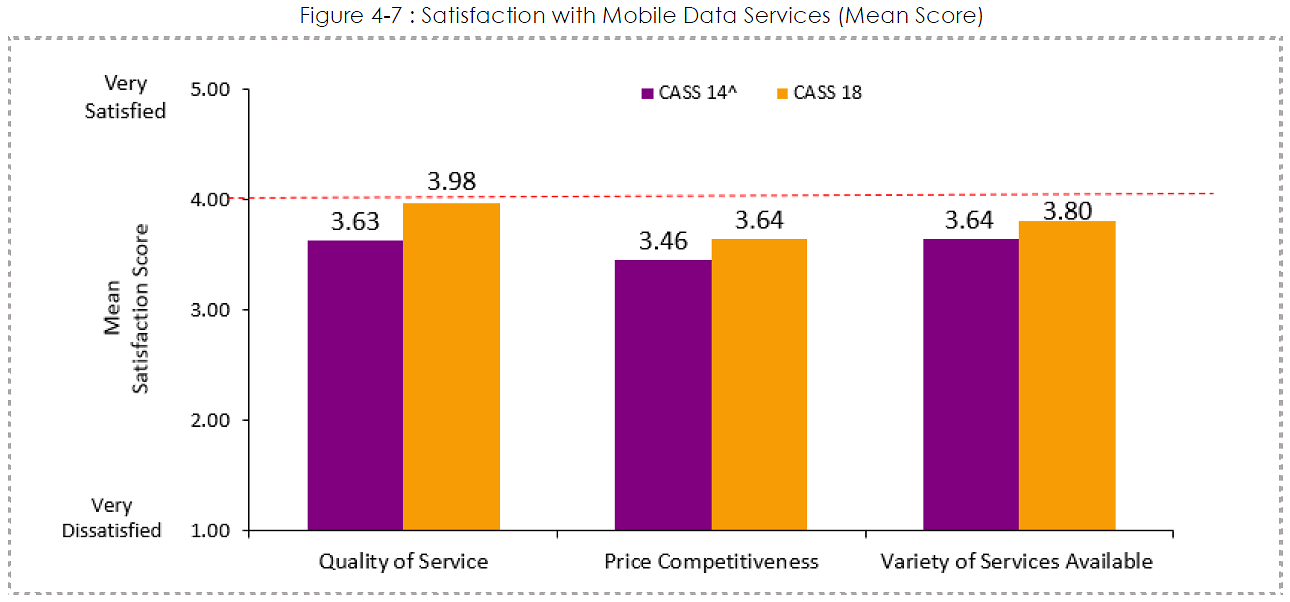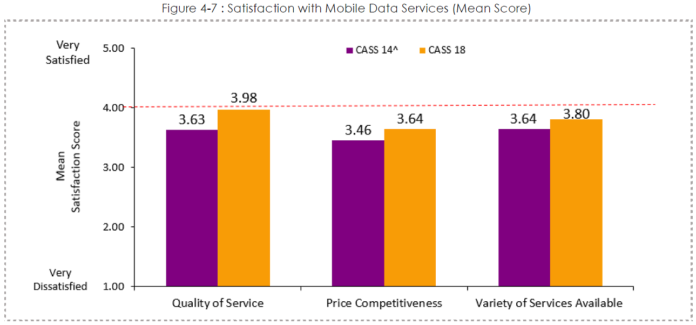SINGAPORE: Consumers in Singapore gave the quality of mobile and broadband services high marks in general, but felt that telco hotline waiting times were too long, according to a survey released on Tuesday (Dec 11) by the Infocomm Media Development Authority of Singapore (IMDA).
The Consumer Awareness and Satisfaction Survey, which is in its sixth cycle, was last held in 2014.
Respondents were asked to rate their satisfaction with key services, including mobile data, fixed broadband, mobile telephone, international roaming and fixed-line telephone, among others.
Ratings for the quality of service were positive for all, with users giving mobile call and messaging services a score of 4.04, mobile data a rating of 3.98 and fixed broadband a slightly lower 3.68.
All five services achieved similar or higher ratings for quality of service compared with 2014. Mobile data service saw the biggest jump, rising from 3.63 in 2014 to 3.98 in 2018.

Consumer satisfaction with mobile data services. (Image: IMDA)
MOBILE COVERAGE
Satisfaction with the coverage of mobile data services outdoors, at home, in offices and shopping malls was at least 4 points.
Satisfaction with the coverage in underground tunnels remained the lowest but improved from 2.77 in 2014 to 3.09 this year.

Consumer satisfaction with mobile data coverage across locations. (Image: IMDA)
Similarly, satisfaction with the coverage of mobile voice and message services was at least 4 points in most areas, but coverage in underground tunnels got a rating of 3.16.

Consumer satisfaction with mobile voice and message services coverage across locations. (Image: IMDA)
COMPARING TELCOS
Among the three main telcos, StarHub saw a “large increase” in its satisfaction mean score for the quality of mobile voice and message services, whereas Singtel Mobile and M1 saw a smaller increase in their mean scores.

Satisfaction with mobile voice and message services by service provider. (Source: IMDA)
Satisfaction with the quality of mobile data services was fairly consistent across the main telcos with all scoring close to 4.

Satisfaction with mobile data services by service provider. (Source: IMDA)
REDUCE HOTLINE WAITING TIME: CONSUMERS
As with previous years, the improvement most respondents wanted to see was a shorter waiting time on the telcos’ hotlines.
Consumers also highlighted the need to have prompt and effective follow-up to complaints, and wanted service providers to improve the competency and product knowledge of customer service officers.

Hotline waiting time by service provider. (Source: IMDA)
Among the service providers, respondents were least satisfied with the hotline waiting time and the time taken to resolve complaints by Singtel, and the competency of customer service officers from StarHub.

Consumer satisfaction on time taken by telecommunication providers to resolve complaints. (Image: IMDA)

Consumer satisfaction on competency of customer service officers across telecommunication providers. (Image: IMDA)
However, satisfaction with customer care has improved for the three main service providers – Singtel, StarHub and M1.
HIGHER USER ADOPTION RATES
The adoption rates of telecommunications services – mobile data (83.8 per cent), fixed broadband (92 per cent) and mobile telephone (96.5 per cent) continued to increase, with the exception of fixed telephone lines, which has been on the decline since 2005.
In particular, subscription to mobile data services among respondents aged 60 and above doubled to 58.1 per cent in 2018 from 25 per cent in 2014.
While mobile plans with a phone subsidy are still the most popular among consumers, SIM-only mobile plans now make up one in six (or 16.2 per cent) of mobile plan sign-ups.
The survey also found that the use of Wireless@SG doubled from 20.8 per cent in 2014 to 43.5 per cent in 2018.
Adoption of international roaming services rose after a drop in 2014 (46 per cent). while payphone usage continued to decline sharply (4.5 per cent).
The survey was conducted between March and May 2018, and involved about 1,500 households representative of Singapore’s population.





